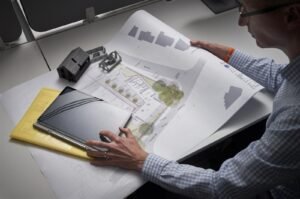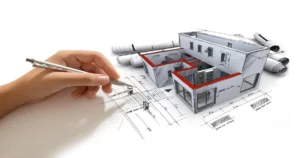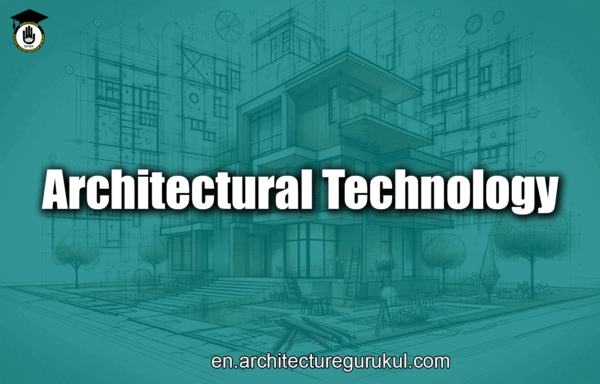Architectural technology is a vital discipline that connects the conceptual vision of architecture with the practical aspects of construction. It involves the application of science, engineering, and technical expertise to ensure that architectural designs can be efficiently, safely, and sustainably realized. As modern architecture continues to evolve, architectural technology plays an increasingly crucial role in shaping the built environment.
Table of Contents
Architectural Technology
The Role of Architectural Technology
At its core, architectural technology is about making architectural designs feasible in the real world. While architects focus on the aesthetics, function, and form of buildings, architectural technologists ensure that these designs can be built efficiently, using appropriate materials and methods. They consider various factors such as structural integrity, environmental impact, energy efficiency, and cost-effectiveness.
Architectural technologists work closely with architects, engineers, and construction teams to develop detailed technical drawings, specifications, and models. Their expertise ensures that the design intent is preserved while adhering to building codes, regulations, and safety standards. They also play a key role in selecting materials and construction techniques that align with the project’s goals.

Key Components of Architectural Technology
Architectural technology encompasses a wide range of areas, each contributing to the successful realization of a building project. Some of the key components include:
1. Building Information Modeling (BIM):
BIM is a revolutionary tool in architectural technology that allows for the creation of a digital representation of a building. This model contains detailed information about every aspect of the building, from its geometry to the materials used. BIM facilitates collaboration among different stakeholders, allowing architects, engineers, and contractors to work together seamlessly. It also helps in identifying potential issues before construction begins, reducing errors and improving efficiency.
2. Sustainable Design:
Sustainability is a major focus in modern architectural technology. Technologists are responsible for incorporating sustainable practices into the design and construction processes. This includes selecting energy-efficient materials, designing for natural lighting and ventilation, and integrating renewable energy sources like solar panels. Sustainable design not only reduces the environmental impact of buildings but also enhances their long-term value and performance.
3. Structural Engineering:
Architectural technologists collaborate with structural engineers to ensure that buildings are safe and stable. They analyze the load-bearing capacity of different materials and structures, ensuring that the building can withstand various forces such as wind, earthquakes, and heavy loads. This aspect of architectural technology is crucial for the safety and longevity of buildings.
4. Material Science:
The choice of materials is a critical decision in any construction project. Architectural technologists must understand the properties of different materials, including their durability, insulation properties, and environmental impact. They also need to stay updated on new and innovative materials that can improve the performance and sustainability of buildings.
5. Construction Technology:
Advances in construction technology have revolutionized the way buildings are constructed. Architectural technologists are at the forefront of these developments, implementing new construction methods such as prefabrication, modular construction, and 3D printing. These technologies can significantly reduce construction time, costs, and waste, making the building process more efficient.
6. Environmental Control Systems:
Architectural technology also involves the design and implementation of environmental control systems within buildings. This includes heating, ventilation, and air conditioning (HVAC) systems, as well as lighting and acoustics. Technologists work to ensure that these systems are energy-efficient and meet the comfort needs of the building’s occupants.

The Impact of Technology on Architecture
The integration of advanced technology into architecture has transformed the industry, enabling more complex and innovative designs to be realized. Some of the most significant impacts include:
1. Increased Efficiency:
Architectural technology has streamlined the design and construction processes, reducing the time and cost involved in building projects. Tools like BIM allow for better project management and coordination, leading to fewer errors and delays.
2. Enhanced Sustainability:
With the growing focus on environmental responsibility, architectural technology has made it easier to design and construct sustainable buildings. From energy-efficient materials to renewable energy systems, technology has provided the tools needed to reduce the carbon footprint of buildings.
3. Improved Building Performance:
Advances in architectural technology have led to the creation of buildings that are more comfortable, energy-efficient, and durable. Technologists can now design buildings that are better suited to their environments, with improved insulation, ventilation, and environmental controls.
4. Innovative Design Possibilities:
Technology has expanded the possibilities for architectural design, allowing for more creative and complex structures. Techniques like parametric design and digital fabrication have enabled architects to push the boundaries of what is possible, creating iconic and innovative buildings.

The Future of Architectural Technology
As technology continues to advance, the field of architectural technology will likely see further developments that will shape the future of the built environment. Some emerging trends include:
1. Smart Buildings:
The integration of the Internet of Things (IoT) into architecture is leading to the development of smart buildings. These buildings use sensors and automated systems to monitor and control various aspects such as lighting, temperature, and security. This not only enhances the comfort and safety of occupants but also improves energy efficiency.
2. Virtual and Augmented Reality:
Virtual and augmented reality technologies are becoming increasingly important in architectural design and construction. These tools allow architects and clients to visualize and interact with a building before it is built, leading to better decision-making and more accurate designs.
3. Sustainable Urban Planning:
As cities continue to grow, architectural technologists will play a key role in developing sustainable urban environments. This will involve the integration of green spaces, efficient transportation systems, and sustainable infrastructure into urban planning.
4. Advanced Materials:
The development of new materials, such as self-healing concrete and smart glass, will further enhance the performance and sustainability of buildings. Architectural technologists will need to stay updated on these innovations and incorporate them into their designs.
Architectural technology is an essential discipline that bridges the gap between design and construction. By integrating science, engineering, and technology, architectural technologists ensure that buildings are not only aesthetically pleasing but also functional, sustainable, and safe. As the field continues to evolve, the role of architectural technology will become even more critical in shaping the future of architecture and the built environment.
